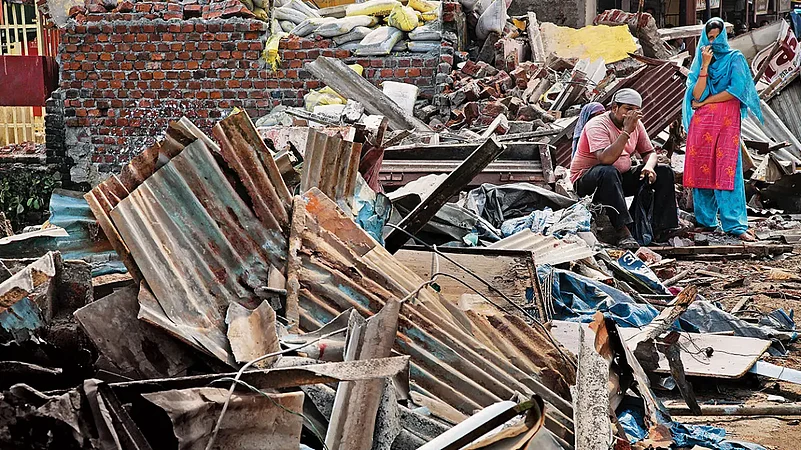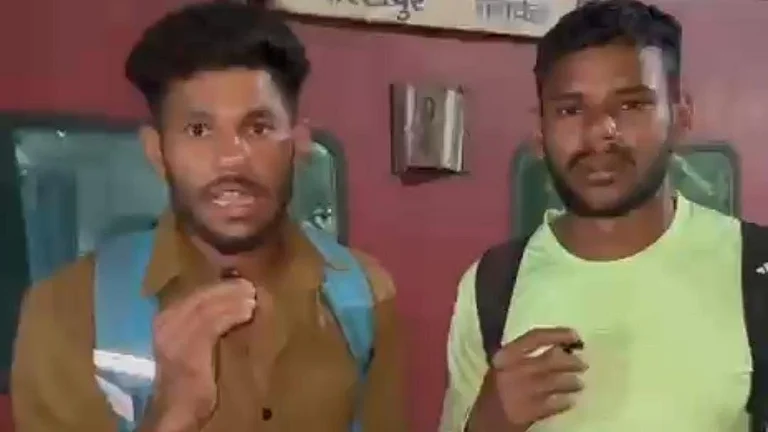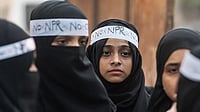It was a rainy morning in 2012 when eight-year-old Shiva Katkari left for school. As usual, his mother dropped him, before she went to work as a domestic help in the buildings close to their home at Shastri Nagar in Thane. His school bag had some books and a small packet of chips his mother had bought the previous evening. As mother and son walked hand in hand to school, little did they realise that the events later in the day would change their lives forever. As Manjula walked back from school, she passed some bulldozers parked alongside the road to her home. At home she had a cup of tea with her husband, who worked as a gardener in the same block of buildings where Manjula was employed. While her husband ate the leftover chappatis from the previous night’s dinner, Manjula went hungry as she was fasting that day. Shiva had eaten a packet of Parle-G biscuits with tea. That was the only meal they had that day.
At work, she received a call from her husband about bulldozers razing houses in the vicinity. As they were Aadhaar card holders who lived in a 225-sq ft “one plus one” structure at the Shastri Nagar basti, they did not give the bulldozers much thought. Then her husband called again, asking her to rush home immediately. “Ghar thodla hota, kahitch nahi rahila (the house had been broken, there was nothing left),” she told Outlook reminiscing the painful memories of that fateful day. “My mother was crying when she came to pick me up at school. I came back to debris that had been our home,” says Shiva, now 17. He lost his school books and has not been to a school since that day.
ALSO READ: Tentacles Of Power
While the children of the basti huddled under plastic covers seeking refuge from the driving rain, the adults had gone in search of “safe” places to pitch hutments. Since that rainy day, the Katkaris like numerous others, faced the civic body’s demolition squad on numerous occasions. “We lost our livelihoods, our money, our food, our Aadhaar cards—everything. Now we pay money to a local dada who protects us from the bulldozers,” said Manjula. “We had Aadhaar cards yet they demolished our houses. What was our crime?” questioned Kumar Katkari—Manjula’s husband. They went from living in a basti with 24-hour water supply and common toilets to a slum colony with no amenities—a population forgotten until the next visit by the bulldozers.
Dr Amita Bhide, professor at School of Habitat Studies in Tata Institute of Social Sciences (TISS), is of the opinion that there is a need to relook at the definition of ‘demolition’. According to her, the moment there is talk of demolition it is presumed that it is illegal. Demolitions in Mumbai and on a whole in Maharashtra are being celebrated and the officers who oversee it are considered upright, Bhide tells Outlook. “On one hand there is unbridled construction taking place, and on the other hand there is the shifting of the displaced. For a building, tracing illegalities becomes difficult and it can take years to demolish such structures. But when it comes to the poor, a generic demolition notice is put up and within hours the demolition takes place,” said Bhide.

Another bureaucrat synonymous with demolitions was Govind Ragho Khairnar, deputy municipal commissioner of the Brihanmumbai Municipal Corporation (BMC), who earned the moniker, ‘Demolition Man’. He was responsible for the demolition of over 100,000 illegal houses across the island city, which included 29 properties of the underworld don Dawood Ibrahim. Thousands of families from the lower middle class and the middle class were displaced across Mumbai. “I lived in Parel with my family. When my house was demolished, I had to move to Virar (a far-flung northern suburb of Mumbai),” recalls Amar Thakur, whose house was demolished over three decades ago. “From a house owner I became a tenant. I lost my job as I could never reach in time from Virar, and my children lost their crucial school years. Today, we keep moving from one rental house to another because we have no money to buy or build a house. Who will compensate us for our emotional trauma?” Thakur currently runs an eatery in Virar.
Demolitions and evictions lead to a huge humanitarian crisis. “There are no legal options when it comes to the poor. The city survives on the labour of the poor, but we do not create legal housing for them. We use the arbitrary line as a cut-off mark to demolish their structures,” says Bhide. Policy makers, she says, must be sensitised to the pre- and post-demolition trauma. “Evictions are negative acts and come at a tremendous human cost. When faced with a bulldozer, the poor have to constantly shuffle between all that they want to save and can actually save. There are documents, food-grains, utensils, belongings, the sparse furniture, and so many other things. They manage to save some things, but a whole lot of it goes under the rubble. After the demolition, the people have to start living again, and they live the most disenfranchised lives on the fringe,” says Bhide.
A former BMC chief who too had ordered the razing of many illegal structures told Outlook that he did it with a heavy heart. “I live in regret. Mumbai today is all about displacement of the poor and the voiceless. Behind every redevelopment talk, there are hundreds of demolitions that have taken place. A vast majority of the original owners never get the benefits of redevelopment,” says the former bureaucrat. He adds that when the poor are displaced and move on to another place, the structures they set up in that part too are considered illegal only to be demolished at some later date. The “demolition displaced” never have any documents as they are in a flux after being constantly uprooted. “The district collector’s office and the civic bodies are allocated monthly targets for demolitions being carried out in months when there’s heavy monsoon, extreme summer or biting cold,” says Bhide. “When a person is living in a temporary shelter, it is presumed that they are illegal which may not be the case,” she adds. Redevelopment has become like a magic wand, a dream shown to the poor and the middle class to lift them from their small, congested homes in derelict buildings across Mumbai, which has had the maximum displacement over the years. “There is only redevelopment taking place in Mumbai. So many major projects have been stalled at an enormous cost to the people displaced,” says Chandrashekhar Prabhu, a housing activist vocal about self-development of structures.

Rewind to February 2004, when the then chief minister Vilasrao Deshmukh had announced the Dharavi Redevelopment Plan (DRP). The state had planned to convert large parts of Dharavi into a world-class business centre with high-rises housing residential colonies. Aimed at transferring over a million people living in Dharavi, from the slums to plush skyrises “to change their lives for the better”, this ambitious project was scrapped due to the political policies of the governments that followed. After 18 years, Deshmukh’s announcements are yet to take off. Deshmukh, who served two terms from 1999 to 2008, passed away in 2012, but the ambitious project his government had planned has been stuck in multiple problems. To date, only 350 residents have been moved into the new houses constructed by the Maharashtra Housing and Area Development Authority (MHADA). The DRP was conceived in the 1990s by Mukesh Mehta, an architect and chairman of MM Project Consultants Private Limited. The Maharashtra government scrapped it in 2011, despite its global tender in 2007 managing to attract 101 companies that were keen on taking on the project. Prior to 2004, there have been small projects going on in various pockets of Dharavi. However, once Deshmukh made the announcement for the redevelopment, all the smaller projects were stopped. “We will never be able to move out of here. These slums get dirtier and more congested. The government showed us dreams and then robbed us of them. We will die here only,” laments Thangamma Murugan, who has been living in the area for decades.
There are over 200,000 hutments in Dharavi, yet only 69,160 are eligible for new houses. Surveys conducted by the BMC indicated that nearly 63 per cent of Dharavi residents were not eligible for new homes. In 2016, a new tender was floated but the project did not attract any new bidders. In 2018, fresh tenders were issued again. In February 2019, Seclink Technology Corporation—a firm based in the United Arab Emirates—was selected. In October 2020, the project was cancelled yet again, this time on technical grounds. Dharavi, considered as an informal industrial township, has numerous small-scale manufacturing units that were not eligible for alternative areas under the redevelopment plan. “Housing was the primary focus and small-scale units were not considered. The project would have been more of a displacement than redevelopment,” notes a state government bureaucrat in the know of developments.
Another stalled redevelopment project—the Bhendi Bazaar cluster redevelopment project—got clearance from the BMC in February this year, to start the construction work in a phased manner. The project is funded and undertaken by the Saifee Burhani Upliftment Trust, established in 2009 to transform the crumbling Bhendi Bazaar area into a residential and commercial space with modern luxurious amenities. Spread over 16.50 acres, the redevelopment project will directly impact 3,200 families and 1,250 commercial establishments housing over 20,000 people. Eleven new skyrises will replace the 250 dilapidated buildings that presently stand
in the area.
The Patra Chawl redevelopment project took off after being on the back burner for 14 years. This project at Goregaon, a Mumbai suburb spread across 47 acres of prime real estate, was cleared in February. Mired in many controversies, the project was taken up by Guru Ashish, a subsidiary of HDIL whose chairman Rakesh Wadhawan was arrested and charged with money laundering in the multi-crore Punjab and Maharashtra Cooperative (PMC) Bank fraud case. Even as 672 tenants were left homeless, Guru Ashish sold a portion of the land to three builders who had constructed high-rises with the sale from the flats. Patra Chawl was originally a barrack constructed by the British government during World War II and the tenants lived in 265 sq ft houses. In the last 14 years, the residents have faced numerous hardships as the builder had not paid them rent, and failed to provide new houses to the existing tenants. “Till we get our houses, this will continue to be a lost dream,” says Vaishali Dalvi, one of the displaced. Lastly, the Kamathipura redevelopment project is yet to take off despite demolitions and displacement that continue to take place there.
(This appeared in the print edition as "Capital of Broken Dreams")
ALSO READ
Haima Deshpande in Mumbai


























